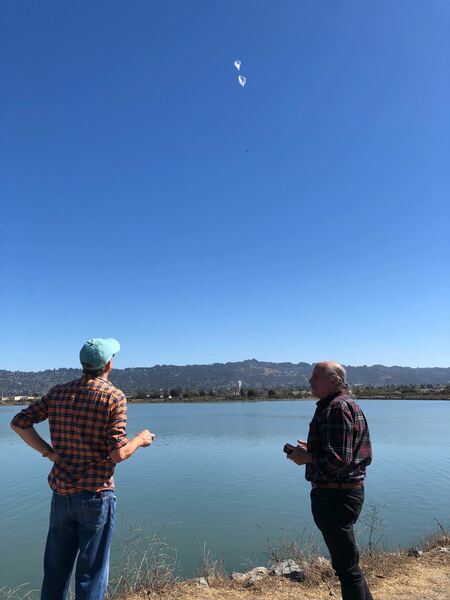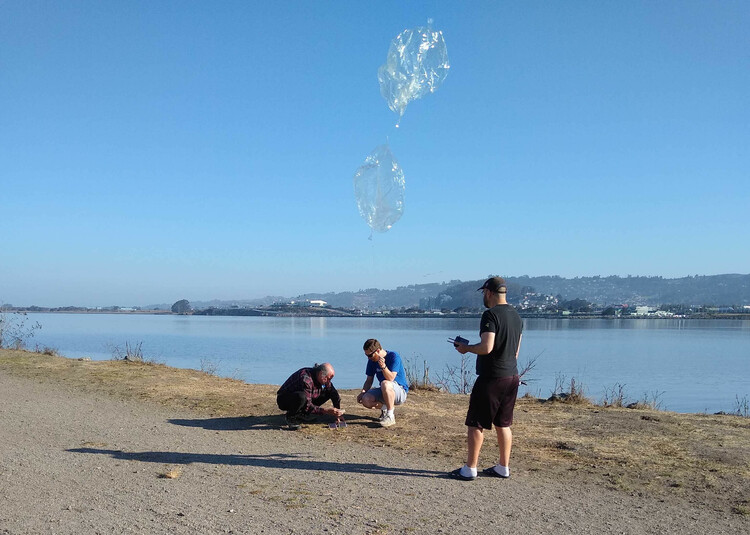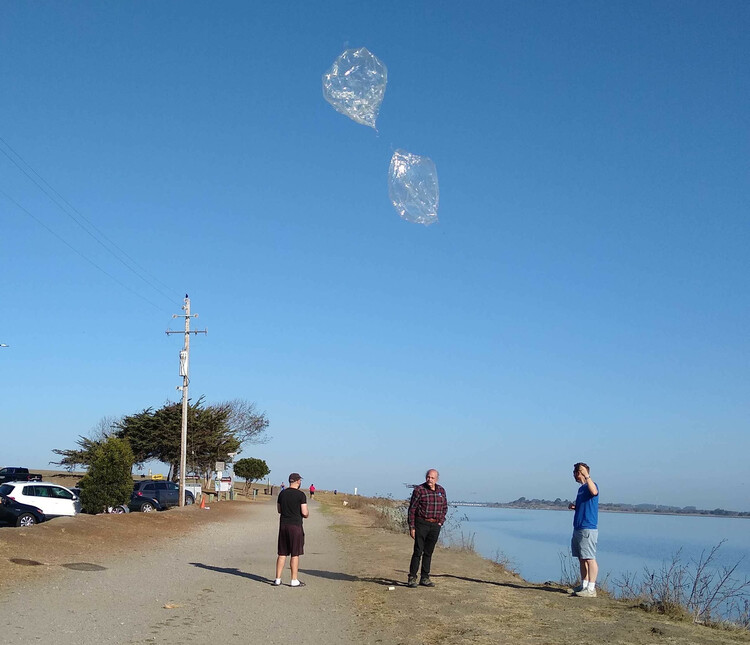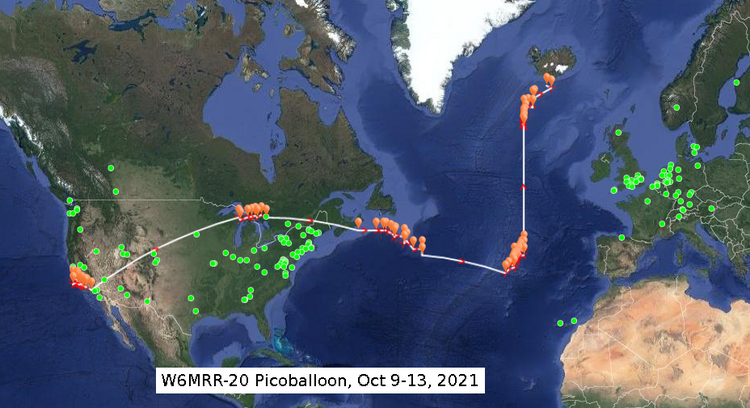In the beginning of October 2021, we had a flurry of launches from the Berkeley Marina. In the span of two weeks, we launched five balloons. All of the picoballoons woke up after launch, which means that we are getting better at building, testing, and launching picoballoons. But unfortunately, only one of them survived the first night and woke up the next day. We can't achieve our goal of going around the world if the picoballoons only last for one day!
All of these picoballoons used the same custom electronics designed and built by Martin W6MRR. Two cheap Aliexpress 36-inch clear plastic balloons were used, with around 6 grams of free lift.
Picoballoon Launch 12: K6RGG-11
On Thursday, Sept 30th, we launched just after noon local time (1900 UTC). The launch party was Martin W6MRR and Robert K6RGG. The tracker turned on about an hour later at 2022 UTC.
This picoballoon was interesting because the tracker alternated transmitting WSPR beacons on 20 meters (14 MHz) and 30 meters (10 MHz). The antenna was the standard 20m dipole, not tuned for 30m, but it seemed to work OK on both frequencies. The tracker firmware transmitted WSPR Type 3 messages, which have a slightly different packet structure that allows 6-digit grid squares to be transmitted. This is much more precise location than the standard 4-digit gridsquares. However, there was a bug in this new firmware that reported the wrong altitude (encoded in the WSPR power field), so it was unclear what altitude we were floating at.
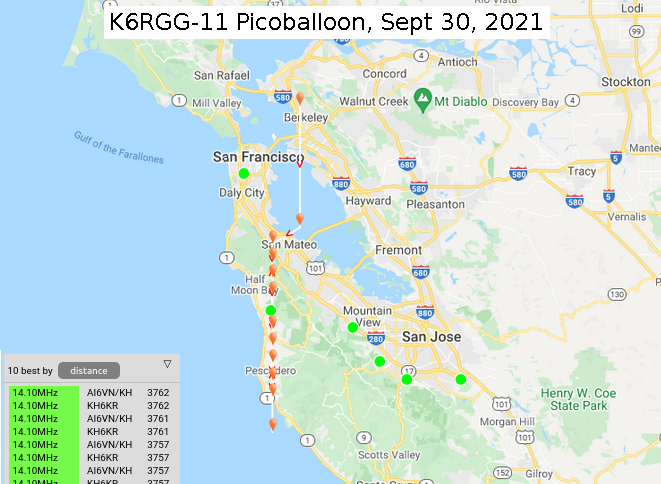
This picoballoon transmitted for about 2.5 hours until 2254 UTC, when it was just off the coast of Santa Cruz, and didn't wake up the next day. A total of 40 transmissions were received on 30 meters, and a total of 16 beacons were received on 20 meters. While there were more packets received on 30 meters, the maximum received distance was a lot shorter at only ~1000 km, versus ~3700 km on 20 meters. Here is a map of the 30 meter activity, but due to the reduced range and smaller receiver network we probably won't transmit on 30 meters again.
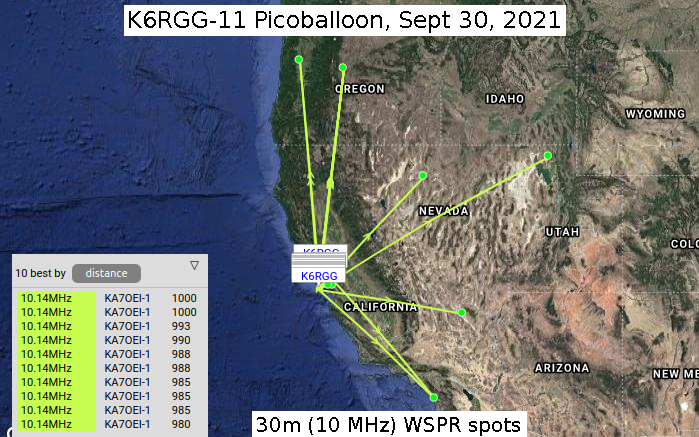
The APRS callsign was K6RGG-11, using the aprsWsprBridge script to copy the WSPR data into the APRS network. Download all the WSPR packets here.
Picoballoon Launch 13: KF6ZEO-11
Picoballoon Launch 13 occurred on Saturday, October 2nd, with Martin W6MRR, Robert K6RGG, and myself KF6ZEO as the launch party. The winds were a bit on the stronger side this time, so we spend about 20 minutes waiting for the winds to die. We eventually walked away from the water and launched about 9:20am Pacific time (1620 UTC).
The balloon started transmitting soon after liftoff at 1634 UTC, and transmitted a total of 69 WSPR beacons on 20 meters. The last packet was received at 2300 UTC from grid CM65hu, which is ~485 km southwest from San Francisco. The picoballoon was reporting an altitude of between 9,000 and 9,900 meters (~29.5k to 32.5k feet), which is a bit lower than our ideal altitude.

Unfortunately, the picoballoon did not wake up the next morning. See the aprs.fi track, and download all the WSPR packets here.
Picoballoon Launch 14: W6MRR-20
A week later, on Saturday Oct 9th, we launched again. This picoballoon was the most successful of this set of launches, floating for five days. It spent a day above the Great Lakes (pdf) before spending three days over the Atlantic Ocean.
The last packet transmitted was only 100 km south of Iceland, with the balloon floating between 9,900 and 11,100 meters altitude (32.5k to 36.5k feet). It turned off at dusk, as it normally does, and at this altitude it should have been above any bad weather. So we're not sure what happened, maybe a pinhole leak or a big thunderhead.
See the aprs.fi track, and download all the WSPR packets here.
Picoballoon Launch 15: KF6ZEO-12
On Sunday Oct 10th, we launched another picoballoon from the Berkeley marina. The callsign was KF6ZEO-12. The WSPR transmitter on this picoballoon worked pretty well, with 58 packets were transmitted from the balloon between 1814 and 2300 UTC. These packets were received 806 times across North America and Hawaii.
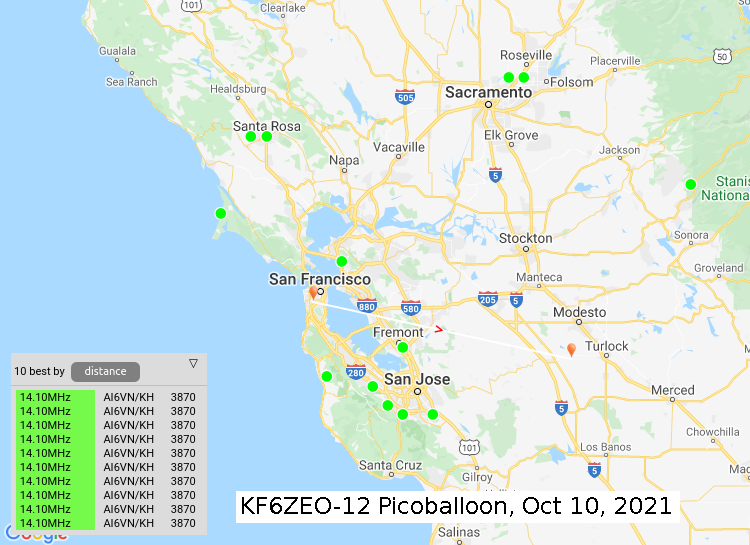
THe high altitude winds were pretty slow that day, with the balloon only traveling one gridsquare east (from CM87 to CM97) before the sun set for the day and the transmitter stopped. Unfortunately, this picoballoon didn't wake up the next morning. Download all the WSPR packets here.
Picoballoon Launch 16: K6RGG-12
On Thursday, Oct 14th, at around 8am we launched K6RGG-12. This picoballoon started transmitting at about 2 hours after launch at 10:04am local time (1704 UTC), and the winds took it directly south.
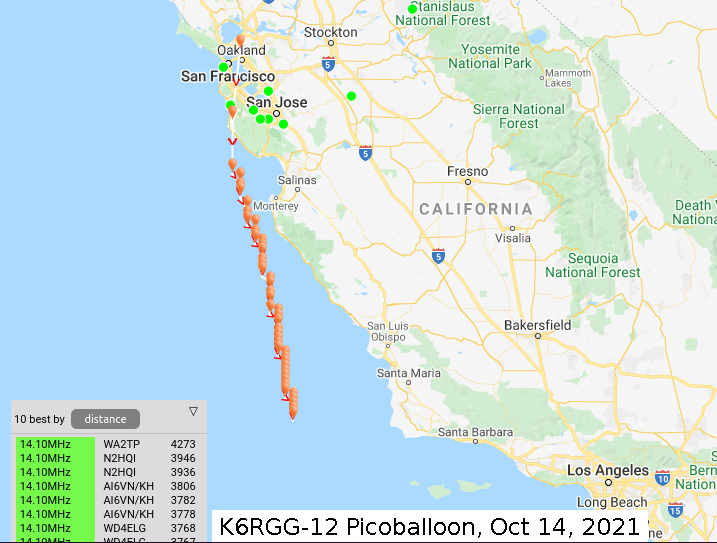
The tracker had an older version of software onboard, so the altitude (encoded in the power field) was not correct. We don't know the final floating altitude. A total of 86 WSPR packets on 20 meters (14 MHz) were transmitted. This picoballoon turned off at 2216 UTC (3:16pm local time), as it was off the cost of Vandenberg Space Force Base. This seems a bit earlier than previous picoballoons, so maybe there were some high-level clouds blocking the sun.
The APRS callsign was K6RGG-12, and download all the WSPR packets here.
Northern Hemisphere Winds in the Winter
Our goal is to float around the world. We got halfway there with W6MRR-18, but with these past few launches we seem to be having trouble just waking up after the first night.
It's now fall in the Northern Hemisphere, and as we head towards winter, the upper atmosphere winds settle down and blow steadily to the east. During the summer, when the sun is pumping a lot of energy into the Northern Hemisphere, picoballoon trajectories are more meandering.
We can see this transition in the HYSPIT forecasts, and also in our balloon flight data. Here is a forecast for the K6RGG-11 picoballoon, launched on September 30th. While it didn't transmit past the first day, HYSPLIT forecasts showed the balloon heading east at a pretty fast clip. The three altitudes on the HYSPLIT forecast, separated by 2000 vertical meters, are pretty much in alignment.
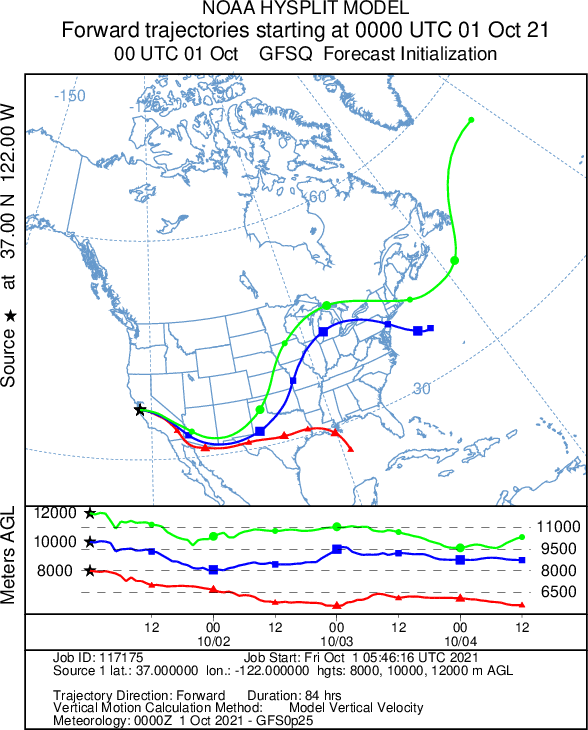
Compare this forecast to our picoballoon launches 7 and 8, which were back in the middle of August, well before the September equinox. Only a thousand meters of vertical elevation would send the picoballoon the exact opposite direction, and even staying at the same altitude had several loops and turn backs.

We plan to launch again soon, and hopefully the winds will become more and more favorable for quickly floating around the world.
Special thanks to Phil Barnard VK7JJ for building the amazing wspr.rocks webpage where all WSPR data is archived and easily accessible in a user-friendly interface.
